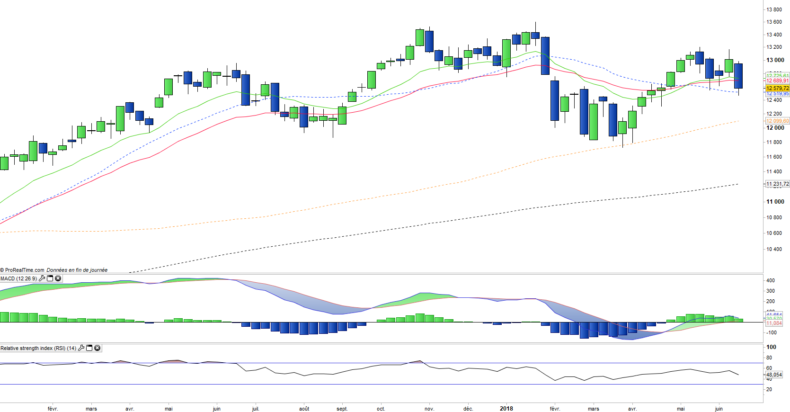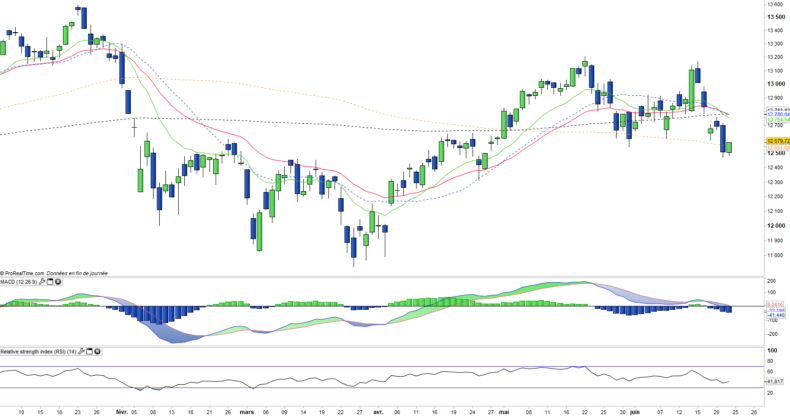DB X-Tracker DAX30 - DBXD - 25/06/2018
Short Term strategy: Negative (40%) / Trend -
Long Term strategy: Positive (90%) / Trend =
pour accéder à nos achats / ventes sur les indices
Characteristics of the ETF
The DBXD ETF (db x-trackers), quoted in Euro, replicates the DAX 30 index which is composed of the 30 largest listed German securities, representative of the main sectors of the economy, while the stocks are selected according to the importance of their market capitalization.
The costs of this ETF are low at 0.09% and AUM is quite high at 3610M €, which makes it one of the best vehicles in terms of costs / liquidity. The replication method is direct (physical) and the dividend distribution is capitalized.
Alternative ETFS: DAX (Lyxor in Euro), DAXEX (iShares in Euro)
Index & components
The top 10 stocks are mainly large industrial stocks such as Siemens or Bayer, while there are only 3 financial stocks: Allianz, Commerzbank and Deutsche Bank, the German master index is relatively small and mostly composed of large industrial groups.
Unlike the English, French or Italian indices, the DAX is also distinguished by the absence of large oil companies that weigh heavily in the weighting of the CAC40, FTSE100 or FTSEMIB40, which is double-edged according to the cycle specific to energy sector.
In addition, the financials weigh only 17,1% of the index, half for the insurance giant Allianz, so the banking sector has a low weight reflected in the well-known weakness of Deutsche Bank and Commerzbank. Conversely, the automotive and chemical sectors are heavier than the other European indices, while the technology sector is mainly represented by SAP (10%) whose market capitalization exceeds € 100 billion.
In summary, the DAX is a fairly strong index from a sectoral point of view which can make it evolve differently from other European indices. German fundamentals are very solid (GDP growth above 2%, historically low unemployment rate at 5.5% and accelerated deleveraging up to 2020).
The main risks concern Germany's main customers, namely the United Kingdom, which could suffer from Brexit, the US in political uncertainty and threatening it with a trade war, Russia which remains a difficult and aggressive neighbor and China because of its commercial practices which also tend to limit access to its domestic market to Western industrialists, particularly in the automotive and technology sectors.
Latest developments
After an increase of 6.9% in 2016, the DAX30 grew by 12.5% in 2017, more than the stoxx600 (+ 10.6%). But the index fell -2.6% since the beginning of the year, which is a lower performance than the Stoxx600NR (+ 0.95%), which is due to the risk of trade war with the US.
Large German export companies such as Bayer, BASF, SAP or Siemens are seen by the market as more vulnerable to protectionist actions from the US or China and more dependent on the global economy. The German economy is based on exports and has everything to lose in a trade war and the general increase of tariffs.
The index is therefore particularly vulnerable at the moment, especially since D. Trump is now threatening to tackle the auto sector by applying a 20% tax on imports. The 3 largest German manufacturers account for around 10% of the capitalization of the DAX and would be particularly affected by the application of this tax.
Weekly data
On the weekly chart, we can see a bearish counter-attack that has been stopped so far on the EMA20 from which it could organize a rebound, but threatens a return to the EMA100 currently located at 12116 pts. A rebounding attempt should be made from there in future sessions, but in case of failure - which seems the most likely assumption - the index should deepen its correction towards the EMA100 level.
Daily data
The daily chart shows a double-top formation that has just been validated by the rupture of the neck line at 12625 pts. In addition, the crossing of the EMA13 and 26 and the downward crossing of the EMA100 and EMA200 complete the negative picture in the short term. Unless a quick recovery above the two long term moving averages, the DAX should continue its corrective movement.
ETF Objective
DBXD is a UCITS ETF, listed in EUR, which seeks to replicate the DAX Index (30 german companies)
Characteristics of the ETF
| Inception date | 10/01/2007 |
| Expense ratio | 0,09% |
| Issuer | Lyxor |
| Benchmark | Indice DAX 30 |
| Code/Ticker | DBXD |
| ISIN | LU0274211480 |
| UCITS | Yes |
| Currency | € |
| Exchange | XETRA |
| Assets Under Management | 3 610 M€ |
| Replication Method | Direct (Physical) |
| PEA (France) | No |
| SRD (France) | No |
| Dividend | Capitalization |
| Currency Risk | No |
| Number of Holdings | 30 |
| Risk | 3/5 |
Country Breakdown
| Germany | 100% |
Sector Breakdown
| Consumer discretionary | 17% |
| Financials | 15% |
| Materials | 15% |
| Health Care | 14% |
| Industrials | 14% |
| Technology | 13% |
| Telecom Services | 4% |
| Others | 9% |
Top Ten Holdings
| Siemens | 10% |
| SAP | 10% |
| Bayer | 8% |
| BASF | 8% |
| Allianz | 8% |
| Daimler | 5% |
| Deutsche Telekom | 4% |
| Adidas | 4% |
| Linde | 4% |
| Fresenius | 3% |


